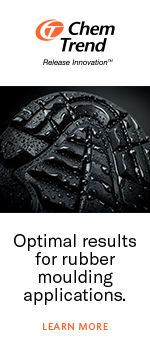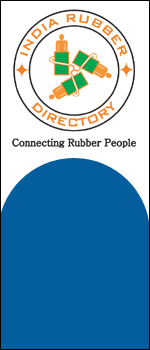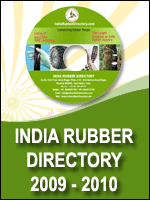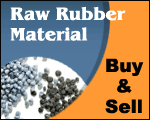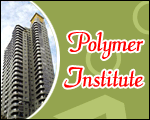EXTRUSION
Baby Kurlakose
In rubber
processing, extruder is mainly used for
shaping the rubber compound into the desired
profile before it is finally processed. The
compound is pushed out through the die either
by the action of a ran or by a rotating screw
inside the barrel.
In the former
case, the extruder is called as the ram
extruder and the latter is known as the screw
extruder. The ram extruder, which is at lower
temperatures and for short runs. In the ram
extruder, it is easy to control the conditions
while extruding difficult compounds. But due
to the high operating costs and lower output,
ram extruders have been replaced by screw
extruders. Now a days, the screw extruders
are used mainly for the production of tubings,
windscreen channels, tyre treads and for the
insulation of wire and cables. It is also
used as a continuous mixer by a jousting the
shape of the screw and a strainer by fixing a
stainless steel sieve at the head,
respectively.
The extruder
consists of a feed hopper, cylindrical barrel,
rotating screw, head attachment and a die.
The screw is driven by an electric motor
reduction gear systems. The compound to be
shaped is fed into the machine through the
feed hopper. It is better to have slightly
slanting position, for easy feeding and quick
take up of the compound. The width of
compound strip fed is slightly less than the
width of the feed hopper and the thickness of
the strip should be slightly less than are
equal to the depth of the flight of the
screw. The barrel is usually made of hardened
steel and is jacketed for the circulation of
steam or cold water. Heating of the barrel is
necessary in the early stages, but as the
material is worked in, temperature. In vacuum
extruders, provision will be made at the
barrel for connecting it to a vacuum device.
The screw of the
extruder is perfect spirally, cut and is
coaxial with the barrel. The pitch of the
screw often decreases gradually from the
driven and to the face and. This helps to
build up constant pressure in the head and to
eliminate air trapped inside the compound.
Since the screw is not expected to chew the
compound at the clearance between the barrel
and the screw, this clearance is kept very
small, usually in the range of the to one half
thousand this of an inch per inch of the
diameter of the screw. The screw is hollowed
out to circulate cold water for controlling
the temperature. For using the extruder to
produce different product and to have better
production control variable speed to the screw
is desirable.
The head
attachment of the extruder varies in shape
according to the purpose for which it is
used. For diverse use of the machine,
detachable head attachments are provided. The
design of the head is very important to get
free movement of the compound at equal
pressures and speeds from all sides of the
head into the die. Any point within the head
where the compound does not more is known as a
dead spotí. Compound gets scorched at these
points and small portions which break away
from these give bits of scorched compound into
the extrudate. The head of the extruder used
for the tyre tread production should be
designed is such a way that the flow at the
center line of the screw is restricted to some
extends so as to get uniform pressure on the
dig. Without this, the rubber compound would
tend to flow very quickly in the middle of the
die and slowly at the extreme width of the
die, thus causing the edges of the extrudate
to break and result in a saw to form.
Provisions for heating and cooling should also
be provided at the head attachment for better
control of the temperature.
The die of the
extruder shapes the compound into the desired
profile. For better shape and finish of the
extrudate, the design of the die is very
important. The die is the hottest part of the
extruder and is usually heated initially by a
gas flame. The cross-sectional area of the
die should never be lower than 5% less or
reader than 30% more of the cross sectional
area of the extrudes. Accessories required
for the extruder depends on the tyre of
product manufacture. The extradite coming out
from the die is usually carried to the next
stage of processing, through, conveyor
systems. For proper control of the dimension
of the product it is desirable to have
variable speed conveyors. Cooling of the
extrudate is done by impression in water, or
by a spray of cold water. The moisture is
subsequently removed by a current of air blown
over it. Tale is applied at the inside of the
tubings while they are being extruded and tale
is applied at the outer surfaces ofter placing
them on rotating tables.
Depending on the
design of the screw and barrel, extruders can
be of three types namely, hot feed, cold feed
and vacuum extruders. The screw of the vacuum
extruder consists of three zones namely, the
feed zone, there is provision at the barrel
for connecting it to a vacuum device. In the
vacuum zone, the screw is either deeper or
more widely cut or the cylinder in that zone
is slightly helps to remove an trace of
moisture on entrapped air from the compound.
Hence it is used in shaping articles for open
steam cure, hot air cure, molten salt cure and
fluidised bed cure. Since moisture, and air
trapped in the compound is removed during
vacuum extrusion, the product will be normally
free from porosity. Depending on the design
of the screw, the extruder may be used for hot
or cold feeding of the compound. The
important differences between the two types of
compound. The important differences between
the two types of extruders are given below:
Hot Feed Extruder
Cold Feed Extruder
I.
Machine Factors
(a) Has got a
short barrel The barrel is
long
(b) The length to
diameter ratio
The length to diameter
ratio of the of the screw
is low ie. In the range screw is
high ie. In the range of 20 : 1
of 5 : 1
2) Rough Surface
or poor finish of the extrudate
Rough surface of
the extrudate can be due to poor dispersion of
the compounding ingredients, scorching of the
compound during extrusion, very high Mooney
viscosity of the polymer, low green strength
of the polymer, very low temperature of
extrusion, low pressure of extrusion and the
to bigger die size. But by proper adjustment
of these factors good finish of the product
can be obtained.
3) Wavy edges
This may be due to
any one of the factors like high temperature
of extrusion, high pressure of extrusion,
lower viscosity of the compound and very
should die area for a big extruder.
4) Low rate of
extrusion
Low rate of
extrusion may be due to any one of the factors
like high viscosity of the compound, low rate
of feeding, lower speed of the extruder, lower
temperature of extrusion and bigger die
section.
5) Porosity
Porosity in the
extrudate may be due to the presence of excess
moisture in the compounding in radiant use of
highly volatile compounding ingredients,
presence of entrapped air, very low viscosity
of the compound and due to under feeding of
the extruder. Proper drying of the fillers
before using, addition of materials like
calcium oxide in the compound and addition of
materials like calcium oxide in the compound
and use of vacuum extruder can reduce porosity
in the extradites.
6). Collapse of
the Material
Collapse of the
extrudate occures when the quality of the
polymer used is poor, when the viscosity of
the compound is very low and when the
processed material is recycled several times.
By elimination the
above mention factors which causes these
defects, it is possible to get high output and
good quality extrudates.
Extrusion










